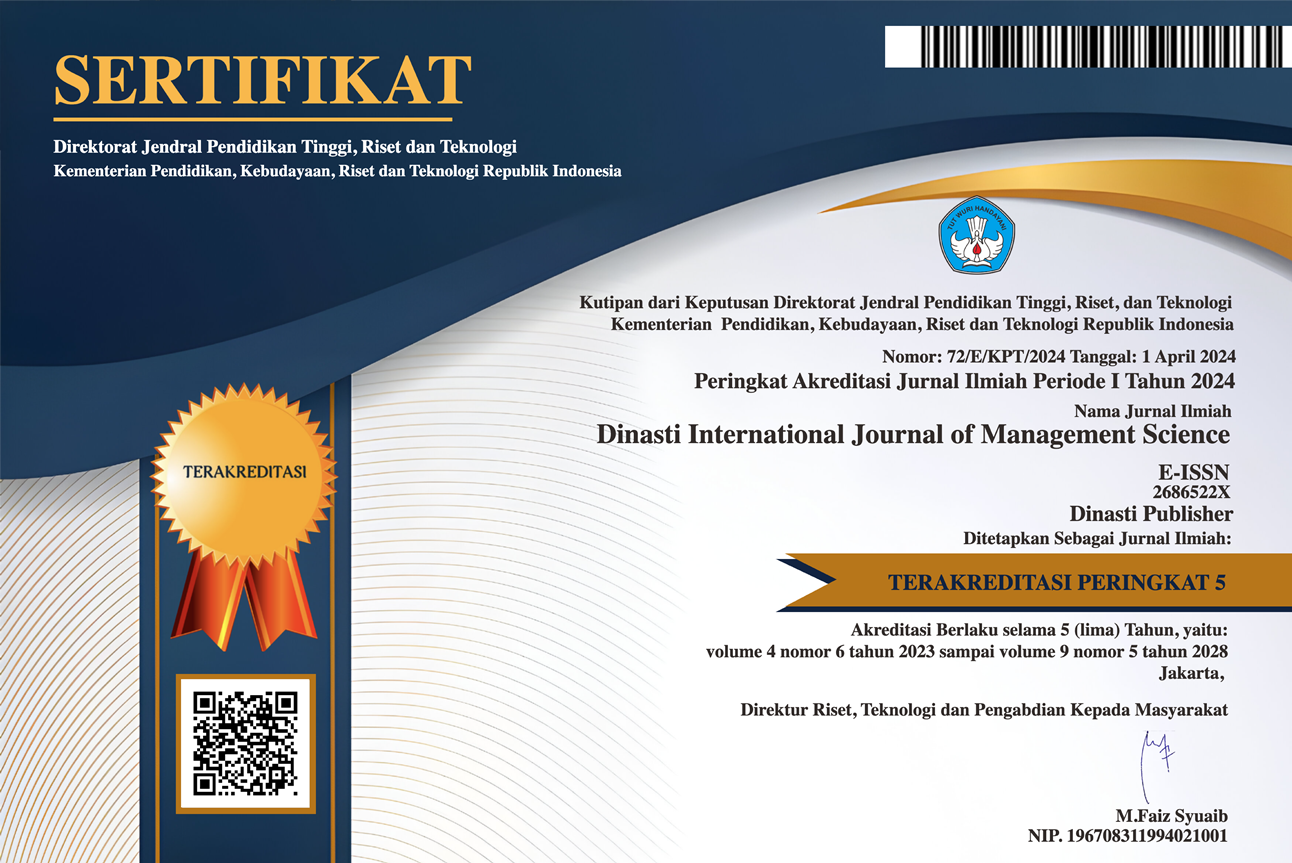Strategies for Controlling Gambling Practices in Military Personnel Settings
DOI:
https://doi.org/10.38035/dijms.v6i4.4341Keywords:
Strategy, Control, Gambling, MilitaryAbstract
Gambling practices are vulnerable among the military. There are many risk factors for gambling addiction, including work stress, being away from family and loneliness, low levels of screening from the start of admission, screening during work, and post-placement. This review aims to identify strategies for managing the impact of gambling addiction on personnel in the military environment. A literature review design was used in this study using the ScienceDirect, PsycInfo, and Google Scholar data bases. The articles reviewed are articles published for the 2020-2024 period. There were 5 articles that met the inclusion criteria and were reviewed. The results of this review show that there is no specific strategy for managing gambling addiction in the military environment, but it needs to be designed to control the negative effects of gambling addiction in the military environment
References
Armstrong, A.R., Carroll, M. (2017). Gambling Activity in Australia: Findings from Wave 15 of the Household, Income and Labour Dynamics in Australia (HILDA) Survey. Australian Institute of Family Studies, Melbourne.
Calado, F., & Griffiths, M. D. (2016). Problem gambling worldwide: An update and systematic review of empirical research (2000–2015). Journal of Behavioral Addictions, 5(4), 592–613. https://doi.org/10.1556/2006.5.2016.073
Champion, H., Pritchard, A., Dighton, G., and Dymond, S. (2022). Gambling problems and help-seeking in serving United Kingdom military personnel: A qualitative study. Front. Psychiatry. Volume 13 - 2022 | https://doi.org/10.3389/fpsyt.2022.1003457
Cowlishaw, S., Metcalf, O., Lawrence-Wood, E., Little, J., Sbisa, S., Deans, C., O’Donnell, M., Sadler, N., Van Hooff, M., Crozier, M., Battersby, M., Forbes, D., McFarlane, A. (2020). Gambling problems among military personnel after deployment. Journal of Psychiatric Research. 131. 47-53. https://doi.org/10.1016/j.jpsychires.2020.07.035
Dowling, N. A., Cowlishaw, S., Jackson, A. C., Merkouris, S. S., Francis, K. L., & Christensen, D. R. (2015). Prevalence of psychiatric co-morbidity in treatmentseeking problem gamblers: A systematic review and meta-analysis. Australian and New Zealand Journal of Psychiatry, 49(6), 519–539. https://doi.org/10.1177/ 0004867415575774
Edens, E. L., & Rosenheck, R. A. (2011). Rates and correlates of pathological gambling among VA mental health service users. Journal of Gambling Studies. Retrieved Feb 29, 2012.
Lloyd J, Nicklin LL, Rhodes SK, & Hurst G. A. (2021). Qualitative Study of Gambling, Deprivation and Monetary Motivations. International Gambling Studies. London: Taylor and Francis.
Paterson, M., Whitty, M., Leslie, P. (2022). Exploring the prevalence of gambling harm among active duty military personnel: a systematic scoping review. Journal of Gambling Studies, 37:529–549 https://doi.org/10.1007/s10899-020-09951-4
Pritchard, A., Dymond, S. (2020). Gambling problems and associated harms in United Kingdom Royal Air Force personnel. Addictive Behaviors. 126: 107-200. https://doi.org/10.1016/j.addbeh.2021.107200
Sharman, S., Dreyer, J., Aitken, M., Clark, L., & BowdenJones, H. (2015). Rates of problematic gambling in a British homeless sample: A preliminary study. Journal of Gambling Studies, 31(2), 525–532. doi:10.1007/s10899- 014-9444-7
Steenbergh, T. A., Whelan, J. P., Meyers, A. W., Klesges, R. C., & DeBon, M. (2008). Gambling and health risktaking behavior in a military sample. Military Medicine, 173(5), 452–459. doi:10.7205/MILMED.173.5.452
Downloads
Published
How to Cite
Issue
Section
License
Copyright (c) 2025 Rio Triawan, Khaerudin Khaerudin

This work is licensed under a Creative Commons Attribution 4.0 International License.
Authors who publish their manuscripts in this journal agree to the following conditions:
- The copyright on each article belongs to the author(s).
- The author acknowledges that the Dinasti International Journal of Management Science (DIJMS) has the right to be the first to publish with a Creative Commons Attribution 4.0 International license (Attribution 4.0 International (CC BY 4.0).
- Authors can submit articles separately, arrange for the non-exclusive distribution of manuscripts that have been published in this journal into other versions (e.g., sent to the author's institutional repository, publication into books, etc.), by acknowledging that the manuscript has been published for the first time in the Dinasti International Journal of Management Science (DIJMS).
















































